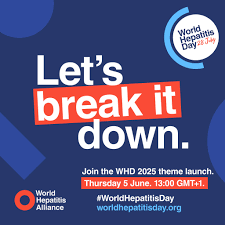July 28th of every year marks World Hepatitis Day, and this year’s celebration is aptly themed “Let’s Break It Down” calling for urgent action to dismantle the financial, social, and systemic barriers, including stigma, that stand in the way of hepatitis elimination and liver cancer prevention.
Here’s All You Need to Know About Hepatitis
Hepatitis is the inflammation of the liver, an essential organ responsible for detoxification, digestion, and metabolism. It can be either acute, lasting less than six months, or chronic, persisting beyond six months. If left untreated, hepatitis can lead to severe complications such as cirrhosis, liver failure, or liver cancer.
Types of Hepatitis
There are several forms of hepatitis, both viral and non-viral. Hepatitis A (HAV) is typically acute and spreads through contaminated food or water; it rarely becomes chronic. Hepatitis B (HBV) can be acute or chronic and is transmitted through blood and bodily fluids.
Hepatitis C (HCV) is primarily bloodborne, often becomes chronic, and carries a high risk of liver damage. Hepatitis D (HDV) occurs only in those already infected with HBV and worsens the infection. Hepatitis E (HEV) is usually acute and transmitted through contaminated water or undercooked meat, posing a significant risk to pregnant women.
Non-viral forms include alcoholic hepatitis, caused by prolonged excessive alcohol use, and autoimmune hepatitis, where the immune system mistakenly attacks the liver.
Causes and Risk Factors
Viral hepatitis is commonly spread through the fecal-oral route (HAV and HEV) or via blood, sexual contact, and mother-to-child transmission (HBV, HCV, and HDV). Alcoholic hepatitis results from long-term heavy drinking, while autoimmune hepatitis arises from an immune malfunction. Other causes include certain drugs, toxins, and metabolic disorders. Risk factors include unprotected sex, intravenous drug use, travel to endemic areas, and chronic alcohol consumption.
Hepatitis Symptoms and Transmission Mode
Hepatitis symptoms can range from mild to severe and include fatigue, jaundice (yellowing of the skin and eyes), dark urine, pale stools, abdominal pain, nausea, and fever. Many cases, especially in the early or chronic stages, may be asymptomatic.
HAV and HEV are spread through contaminated food and water and poor hygiene. HBV, HCV, and HDV are transmitted through contact with infected blood, sexual activity, or from mother to child during childbirth. Non-viral hepatitis is not contagious and is linked to lifestyle or immune-related factors.
Diagnosis
Diagnosis typically involves blood tests to detect viral antigens, antibodies, and liver enzyme levels. Imaging studies like ultrasound or a liver biopsy may be used to assess liver damage. Routine screening is recommended for individuals at higher risk.
Treatment, Prevention and Management of Hepatitis
Treatment varies by type. HAV and HEV are usually self-limiting and managed with rest and hydration. Chronic HBV is treated with antiviral medications, while acute cases may require only supportive care. HCV can now be cured in over 90% of cases with modern antivirals. HDV is managed alongside HBV treatment. Alcoholic hepatitis is addressed through alcohol cessation, nutritional support, and sometimes corticosteroids. Autoimmune hepatitis requires immunosuppressive therapy such as prednisone. In advanced cases, a liver transplant may be necessary.
Prevention strategies include vaccination for HAV and HBV, with combined A/B vaccines also available. Practicing good hygiene, consuming safe food and water, using sterile needles, and practicing safe sex are key to preventing viral hepatitis. Routine screening for at-risk individuals and avoiding alcohol and toxins also help reduce the risk.
Chronic hepatitis, particularly from HBV and HCV, can lead to cirrhosis, liver cancer, or liver failure. Globally, over 325 million people live with chronic HBV or HCV, and hepatitis causes more than 1.3 million deaths annually.
Managing hepatitis involves regular medical checkups, adhering to treatment plans, maintaining a healthy diet, and avoiding alcohol to prevent further liver damage and complications.
























